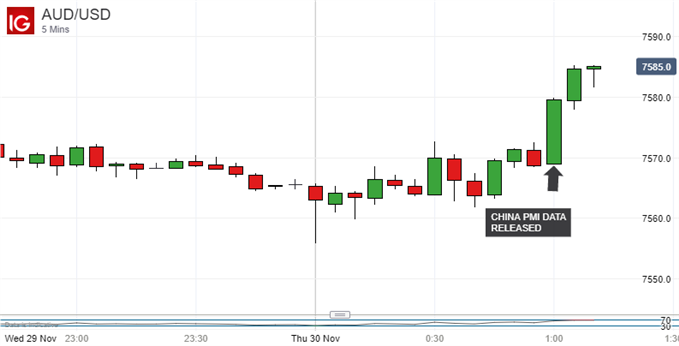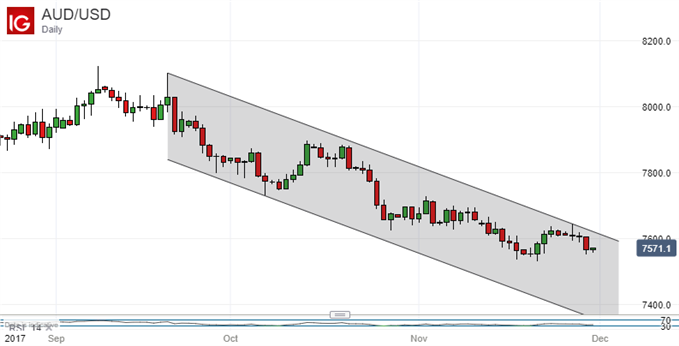Talking Points:
- Chinese Purchasing Managers Index data came in comfortably ahead of forecasts
- Both the manufacturing and service sectors appear to be chugging along as the year bows out
- The Australian Dollar got a clear boost from the data
Find out what retail forex traders think of the Australian Dollar right now on the DailyFX Sentiment Page.
The Australian Dollar gained a little Thursday after a brighter-than-expected snapshot of China’s manufacturing sector.
November’s official Purchasing Managers Index came in at 51.8. That put it above both the 51.4 expected and October’s 51.6. This is quite a strong reading by the standards of the past twelve months too, only beaten by September’s 52.4. Any PMI reading above 50 signifies expansion for the sector in question.
The non-manufacturing print was 54.8, above October’s 54.3. These official surveys cover large concerns, which often have heavy state involvement. Smaller, private firms are scrutinised by the Caixin PMI releases. November’s version of those will be released this week and early next.
Still, the official survey speaks to a Chinese economy heading into year-end in pretty good shape. The Australian Dollar can act as a liquid China-market proxy for foreign exchange investors and seems to have done so in the case of these latest data. AUD/USD certainly rose smartly after their release.

More broadly however the Australian currency remains caught in a long downtrend from 2017’s highs, of which another upside test has just been rejected. Fundamentally the currency is suffering on many counts. For one, the expected December US interest-rate increase will see the Aussie’s long-held yield advantage over the US Dollar finally eroded, with more US hikes widely expected even as the RBA is tipped to stand pat, possibly for all of 2018. The prospect of a higher-yielding greenback will seriously diminish the Aussie’s international attractions.
Admittedly the Australian economy is not performing badly by many yardsticks, especially that of job creation. However, wage inflation remains weak, while an elevated housing market and an indebted consumer base are seen as constraining the central bank when it comes to higher rates.

Morover, the RBA has long been vocal in its opinion that a higher currency hurts both growth and its chances of hitting inflation targets. The suspicion that the Aussie is performing rather as its home central bank would like may also be behind some of its current weakness.
--- Written by David Cottle, DailyFX Research
Contact and follow David on Twitter: @DavidCottleFX






